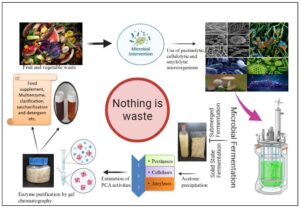Back to: MICROBIOLOGY 400 LEVEL
Welcome to class!
Hello my superstar learner! I’m truly proud of the energy and focus you bring to your learning journey. You’re building a strong foundation that can power innovation across Africa. Today, we’ll discuss Immobilised Enzymes—a smart way scientists and industries reuse enzymes to make processes more efficient and cost-effective. Let’s make it simple, practical, and very relatable.
Immobilized Enzymes
What are Immobilised Enzymes?
Imagine you have a kitchen sponge soaked with detergent. You use it over and over again to wash plates without pouring fresh detergent each time. That’s exactly how immobilised enzymes work. Instead of allowing enzymes to float freely in a solution, they are fixed or trapped onto a solid support, so they can be reused multiple times without being lost in the product.

Immobilised enzymes are enzymes that are attached to or trapped in a solid material so they can carry out reactions without being washed away. This makes industrial processes cheaper and more efficient.
Methods of Immobilisation
Adsorption
Enzymes stick to surfaces like glass beads or charcoal through weak forces (like a magnet sticking to your fridge).
Advantage: Simple and cheap.
Limitation: Enzymes can detach easily if the solution conditions change.

Entrapment
Enzymes are trapped inside a gel-like substance, such as alginate or polyacrylamide.
Analogy: Like egusi seeds trapped inside melon cake.
Advantage: Protects enzymes well.
Limitation: Sometimes slows down the reaction.
Covalent bonding
Enzymes are chemically bonded to a support like silica or cellulose.
Advantage: Very stable and strong attachment.
Limitation: More expensive and may reduce enzyme activity.
Cross-linking
Enzymes are joined together using chemical agents to form large, stable enzyme networks.
Used in: Industries where high enzyme stability is required.
Why Immobilise Enzymes?
Reusability: They can be used again and again, saving money.
Stability: They withstand higher temperatures and pH changes.
Ease of separation: Easy to remove from the product at the end of the reaction.
Efficiency: Useful in continuous production systems like in sugar factories or drug manufacturing.
Real-Life Applications
Glucose isomerase is immobilised and used in producing high-fructose corn syrup (used in soft drinks).
Lactase is immobilised to break down lactose in milk for people who are lactose-intolerant.

Proteases are immobilised for use in detergents and leather industries.
Nigerian Scenario
Imagine a beverage company in Lagos producing fruit juice. They use immobilised pectinase to break down fruit pulp continuously. Instead of adding new enzymes for every batch, they reuse the immobilised ones—saving money and reducing waste.
Summary
- Immobilised enzymes are enzymes fixed onto solid materials for reuse.
- Methods include adsorption, entrapment, covalent bonding, and cross-linking.
- Benefits include reusability, stability, easy separation, and suitability for industrial use.
- Applications include juice production, lactose-free milk, and sugar processing.
Evaluation
- What does it mean when an enzyme is immobilised?
- List and briefly describe two methods of enzyme immobilisation.
- Mention two advantages of using immobilised enzymes in industries.
You’re learning the kind of science that transforms industries and improves lives. Afrilearn is here to fuel your journey every step of the way. Stay curious, stay committed—you’re building something great. See you in the next exciting class!
